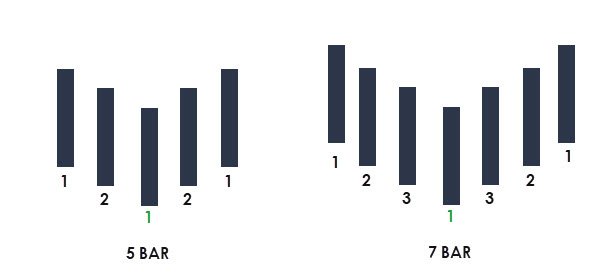- July 5, 2022
- Posted by: CoachShane
- Category: Trading Article

Setting a protective stop loss or at least knowing where you will exit your trade is one of the most vital aspects of trading. Your stop loss defines your risk in the current trade which will allow you to position size correctly. For the most part, traders will use some type of price structure when they first enter their position.

A common example is a breakout over resistance and then a pullback. A trader enters when price reversals and labels 1 and 2 define the general locations a trader will use for an initial stop.
But when the trade moves in your favor and you are looking to push your trades, how can you define your trailing stop? While there are a few indicator ways to define your stop location, price action can be the best way to approach this.
5 and 7 Bar Stop Loss Pattern
A common approach to stop loss placement is using a swing point on the chart. However, you should have an objective way to determine what constitutes a swing point in the market. Using a five bar or 7 bar price pattern will help you become more disciplined in your approach.

The idea behind using this pattern is you are moving your stop loss once price is confirming it’s resuming the trend. Granted, the confirmation may only be for the next bar and price crashes back down. That’s the world of trading. The 5 bar will give you more opportunities to lock in profit while the 7 bar may take a little longer to form.
In the example graphic above, we are assuming the bars to the left of the green “1” have lower lows coming into the bottom and higher lows coming out of it. That is a conservative approach and you must choose whether you will use a slightly more aggressive pattern.

You can see this version of the pattern is not as strict and only requires the lows (for a long) to be above the main “1” bar as opposed to being consecutive.
5 Bar Pattern Stop Loss
Let’s examine a chart of NIO assuming you shorted this stock.

Where you shorted this stock is labelled and the initial protective stop location is above the swing high prior to entry. At number 1, we have the conservative level where the two candles on either side of of the highest candle, are lower highs.
At number 2, we see the aggressive example where on the left of the high candle, we have a lower high but a higher high preceding it.
A trader may choose to be conservative after entry and then use the aggressive stop loss zone after price has advanced further. It makes sense that after price has been on a trending run, a trader chooses to become more aggressive in locking in their gains. Mean reversion is a real threat after price has extended and a snap back in price is very common.
This example has an aggressive adjustment as the first zone. If using the conservative/aggressive method, you’d skip this first zone and wait for the conservative that shows up at number 1.

Personally, using the aggressive approach with a buffer under (over) the middle candle is my choice. You can use a multiple of the average true range as the buffer zone.
For example, if the ATR is $1.60, 1 ATR would be $1.60 while .5 ATR would be an .80 cent buffer.
7 Bar Pattern Stop Loss
We will add one more bar to each side of the middle bar giving us 3 on each side. Again, you can be strict and look only for the conservative swing point but you can be guaranteed of leaving a lot of profit on the table.

Number 1 gives us our first trail on the protective stop using a .5 X ATR buffer. The buffer is important because price, upon return to the level, has a tendency to dip into the previous range. We get another 7 bar adjustment however since the low of the candle minus the .5 ATR, would move the stop loss further away from price, we leave the stop as is.
Day Trading Futures
The last example will be a recent chart of crude oil futures, a popular instrument to day trade, and using the 7 bar pattern. The short trade comes after a gap down in the morning, a pullback, and then a trendline break.

After getting our first placement, we get a pullback, however using this one, we’d be moving the stop further from price. The stop at 2 is the next zone and you would have locked in 4.25 points or $4250/contract.
Simple Solution
This is a simple approach to trade management and one that is grounded in the reality of the market. You have an objective way to lock in your profits using price and not a derivative as you would with a trading indicator.
While you can approach it from a conservative side, I think you will find that through testing, you will end up leaving too much profit on the table. What’s important is that you can be objective with any trade you are in. You have a set plan you can use which, to the downfall of many traders, is not as common as you may think.
Test out this objective way to lock in profit that takes out any greed or fear you may have. You may find your ability to stay in a trade improves which can lead to greater profits.
